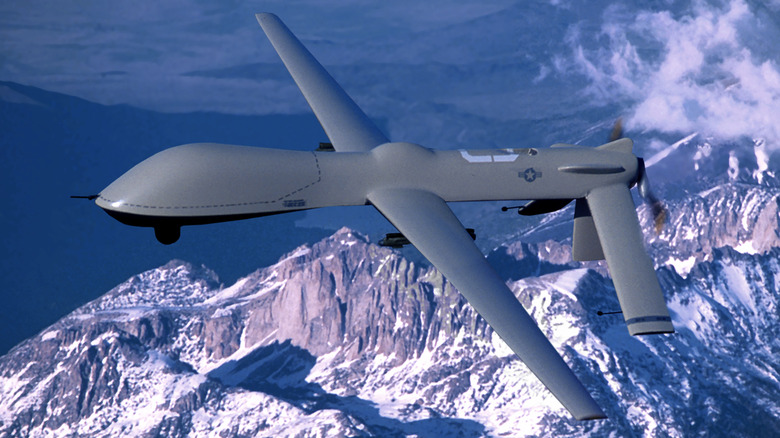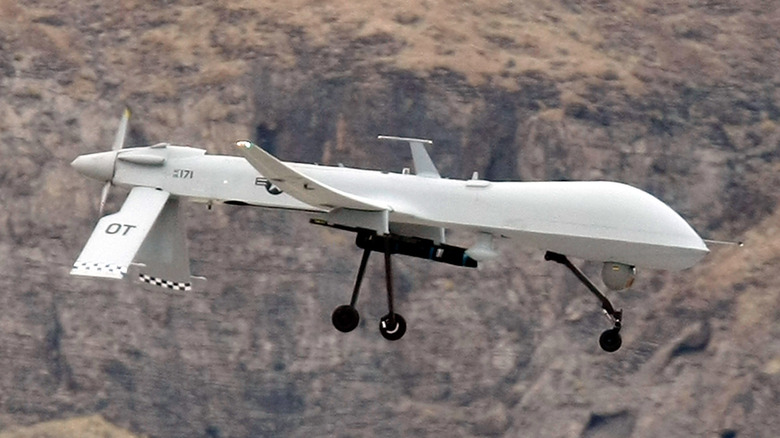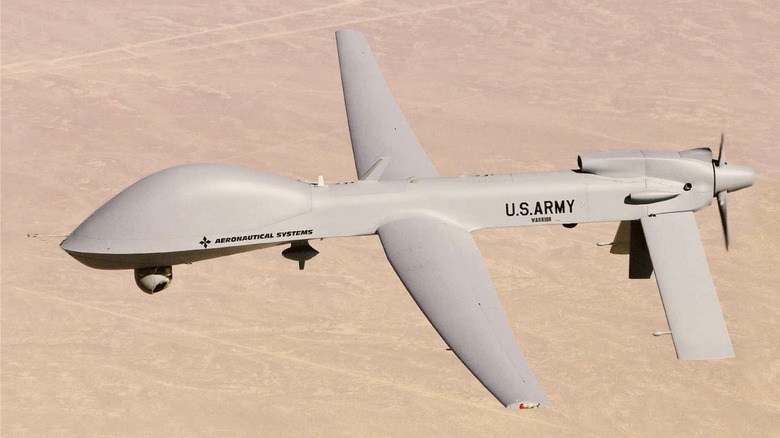How Fast Is The MQ-1 Predator Drone & What Does One Cost?
The United States military has been operating drones for decades, but there's one Unmanned Aircraft System (UAS) that most people know: the MQ-1 Predator, which is one of the best military drones in the world. Initially, the Predator was introduced as a reconnaissance aircraft, providing persistent intelligence, surveillance, and reconnaissance (ISR) for troops on the battlefield. This made it possible for personnel to move safely through an area, as they had overhead coverage that could spot enemies and report immediately to the personnel on the ground.
In 2002, what was called the RQ-1 was redesignated MQ-1 after the Predator was given an armed reconnaissance role. This was a new means of delivering ordnance on targets, and in the years since the Predator became a highly lethal killing machine. Because the Predator is a UAS, it operates differently from traditional fixed-wing aircraft. The Predator isn't particularly fast, moving at a cruising speed of 84 mph with a maximum speed of 135 mph. It can also carry a payload weighing 450 pounds, giving it versatility.
The Predator system came packaged with four aircraft, a ground control station (GCS), and a primary satellite link communications suite. The system cost $20 million in 2009, and the Predator served U.S. operations between its introduction in 1995 until it was retired in 2018. The Predator was replaced by the MQ-9 Reaper, which is a larger platform capable of carrying out the same types of operations with much more ordnance. Over the course of the program, General Atomics produced 268 airframes for its Predator UAS.
The MQ-1 Predator
The Predator is remote-operable from anywhere in the world via its satellite uplink, so pilots aren't put into danger when flying combat operations. This makes the Predator and other UASs in the inventory a cheaper and safer option when air superiority isn't guaranteed. Even when the U.S. has air superiority, as it did in Afghanistan and Iraq in the early 21st century, the Air Force relied on Predators for a variety of missions, including ISR, armed interdiction, and more.
The Predator aircraft is large but light, boasting a 55-foot wingspan, a 7-foot height, and a length of 27 feet. Still, the aircraft isn't heavy, weighing 1,130 pounds before adding up to 450 pounds of payload. In terms of payload, the Predator could carry two laser-guided AGM-114 Hellfire missiles, but it could also take all kinds of ISR equipment and sensors to deliver time-sensitive intelligence information to commanders on the ground.
One of the key elements in the Predator UAS that made it such an enduring presence on the battlefield was its endurance. A Predator can operate continuously for 40 hours, so as an ISR asset, they were exceptionally useful. A Predator's combat range was 770 miles, so it could take off from an airbase far from a combat zone, enter the airspace, and operate for more than a day. They required two personnel for operation: a pilot and a sensor operator, and the aircraft changed how wars were fought, paving the way for much wider use of drones in combat.
What happened to the Predator?
The U.S. Air Force retired the Predator in 2018 to make way for the MQ-9 Reaper, which will retire in 2035, but not because the Predator wasn't an effective system. The Reaper is very much a successor to the Predator and includes many of the same technologies that made the Predator an agile reconnaissance and attack drone. The Reaper is larger and has greater capabilities, so it makes sense that the USAF would want to move in that direction. Just over 100 Predators remained in the inventory by the time the USAF retired the program.
Since its retirement, the Predators haven't been mothballed or thrown into museums — well, some are in museums, but the operational fleet still flies. The airframe continues to serve as the MQ-1C Gray Eagle for the U.S. Army, while other aircraft have been sold to partner and allied nations. The Gray Eagle is an upgraded and updated version of the Predator, which has been in service since 2004. Throughout the program, General Atomics produced 204 Gray Eagles as of 2019.
The Gray Eagle system comes with four aircraft, two Universal Ground Control Stations (UGCS), seven Ground Data Terminals, a Mobile Ground Control Station, and a Satellite Ground Data Terminal. The Gray Eagle system costs $21.5 million and features an automated takeoff and landing system. The aircraft can fly up to 192 mph to a service ceiling of 29,000 feet, has an endurance of 25 hours and can carry twice the weapon payload as its predecessor.
[Featured image by U.S. Army via Wikimedia Commons | Cropped and scaled | Public Domain]


